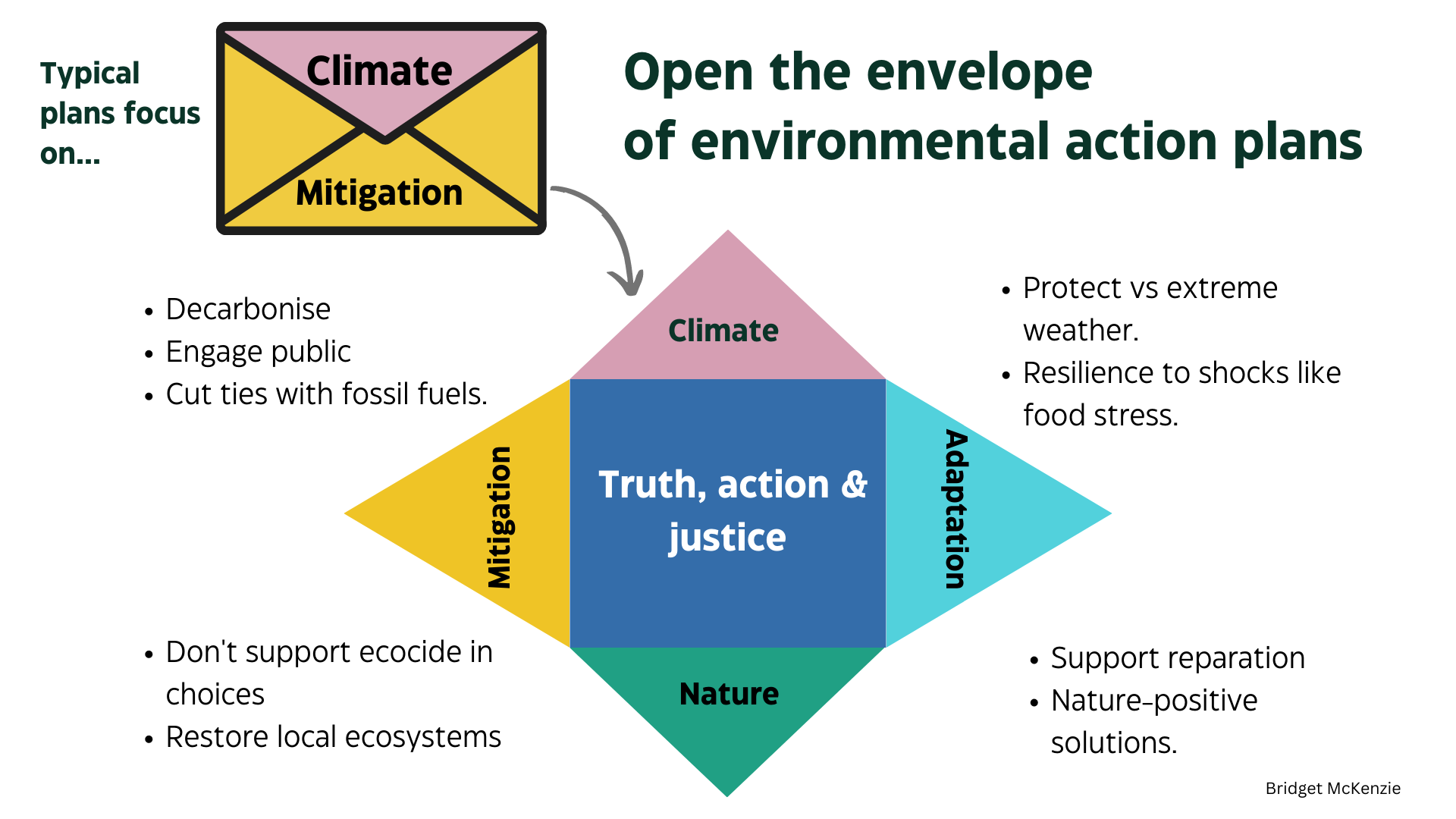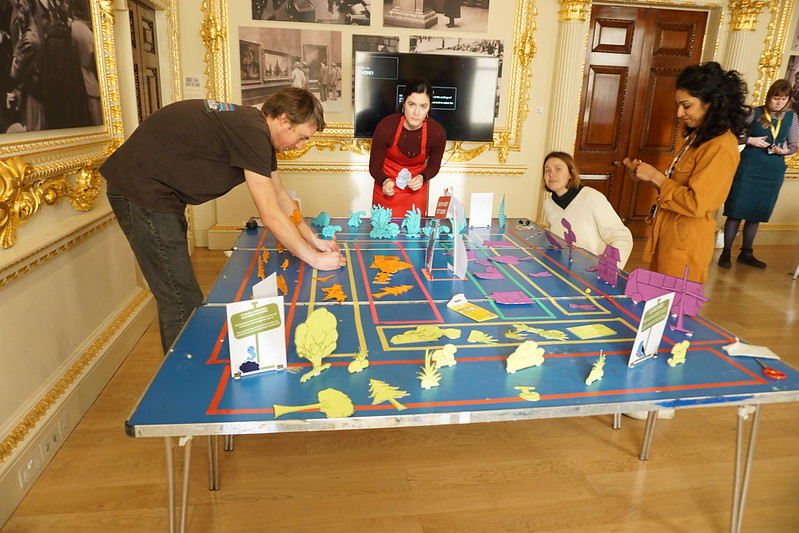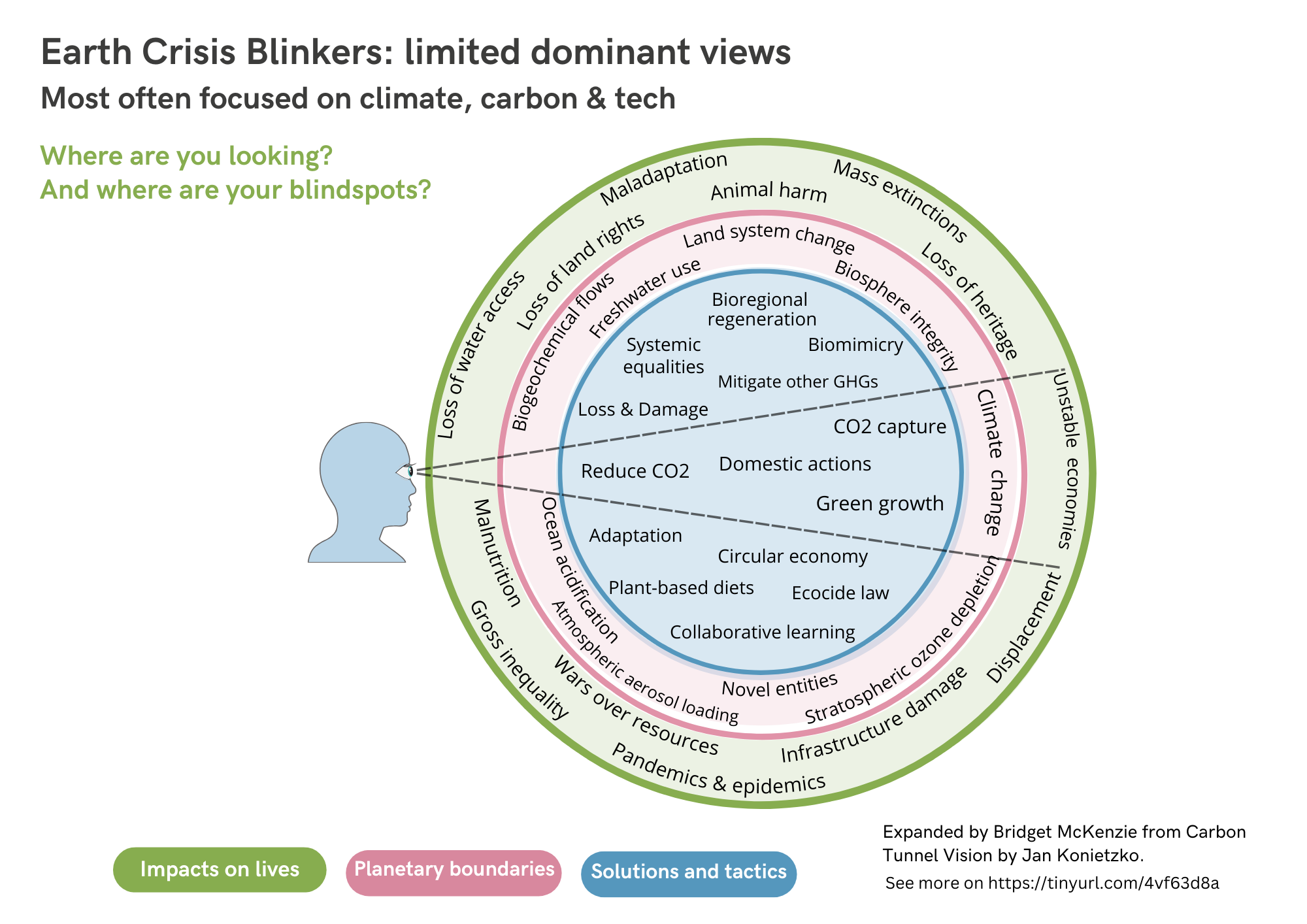Open the envelope
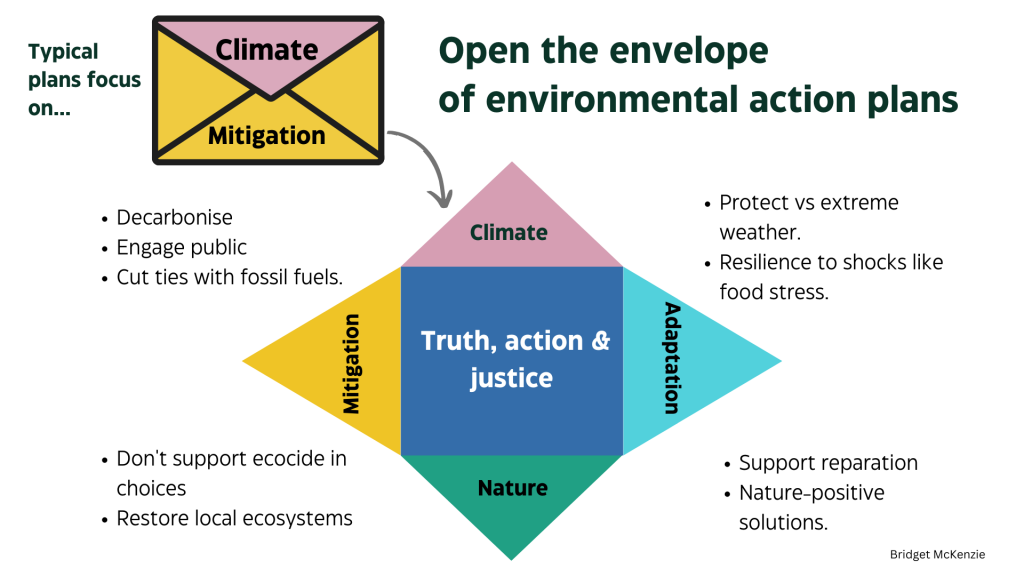
I argue that we need to open out the envelope on environmental policies, in all sectors in general and, because it’s my area of work, in the Cultural sector in particular. The focus of sustainability work has been on Climate and on Mitigation, with an emphasis on reducing consumption and waste, or offsetting these, often with seemingly greater concern about reputation than about making a real impact.
I believe that the Cultural sector must now be Collapse-aware, and focus on adaptation, transition, and resilience. It has to centre Justice, and include Nature in its plans too.
The UN has said the climate crisis is ‘out of control’ as the planet enters a time of record-breaking heat. It is accepted that the aim of limiting warming to 1.5C is now impossible due to baked in emissions, and as tipping points are starting to kick in. People in the hottest, most exploited and most vulnerable regions are increasingly those seeking refuge in places like Northern Europe, which in itself is suffering some extreme impacts (e.g. average temperature increases are higher than any other continent). Meanwhile, governments and industries continue to extract coal and oil, to destroy forests, mountains and ocean beds, to pollute air and rivers, to deplete soil and fill land with waste.
This all means acknowledging that we are running out of time to act and that we must unite for humanity and biodiversity to survive. This is the moment we must choose our future, reviewing everything we have to see how we can protect it and how we can use it for a transformative shift.
I’ve believed for decades that the Cultural sector has a major role to play in:
- telling truths about the severity, complexity and multiple impacts of the emergency
- to speed up learning, planning and action in response to the emergency across the professional and civic communities they can influence
- to be part of local work for adaptation, transition, and resilience in their communities, in ways that centre justice.
The possibilities include:
- Helping people in local communities transition beyond the current high-carbon and anti-nature system — including therapeutic support, providing space for imagining futures, and enabling access to resources.
- Bringing arts and heritage to inspire efforts to be more resilient to climate impacts e.g. showcasing ways that farming, transport, architecture and landscape design can protect against threats of flood, heat or drought.
- Supporting communities with loss of heritage — for example of wild spaces, farmland, housing, older buildings, or streetscapes that are damaged by climate impacts, or that might be decommissioned in anticipation of their impacts.
- Helping to restore biodiversity — enabling sensitivity to nature, inspiring and creating new habitats, defending existing wild spaces, and promoting nature-based solutions to climate resilience.
- Decolonising cultural programmes and collections, and encouraging compassion and aid for migrants and refugees, tackling racist hostility towards newly arrived people.
- Encouraging local systems that bring better mental and physical wellbeing to people e.g. multi-solving tactics that reduce pollution, increase exercise, increase insulation of homes, increase eating of plants, or that limit infectious diseases.
- Drawing on arts and diverse cultures to innovate and support protection of heritage against climate impacts e.g. design of effective flood prevention measures or ways of planting drought-resilient gardens.
This is all difficult work in an extremely challenging and worsening situation, but there are always more positive routes that we can take. We are all in the foothills of the mountain, readying for the climb, and we need to collaborate to make the best chances for our practices, our communities and our living planet.
Here are some resources and links for this journey, for as soon as you are willing to take the necessary path.
- Climate Museum UK
Through my organisation, I and colleagues offer training, mentoring, creative consultancy and research for cultural (arts, heritage and science) organisations and networks on:
- How to grasp and communicate the climate and ecological emergency
- How to put an eco lens on your collections and sites
- How to plan for a changed future, supporting creation of an environmental policy that includes adaptation
We’re also creating other training offers that focus on how people can take action, about language & conversations, and about mental health. In particular, a new offer is a People Take Action workshop, which is about expanding awareness of actions people can take to increase their sense of agency. We can train trainers in this methodology, or deliver workshops directly with community groups, and we offer this toolkit for you to deliver your own.
2. Culture Takes Action
For Culture Declares I’ve developed resources for cultural practitioners and organisations, laying out 8 pathways for action, which include working for transition and adaptation. If you join Culture Declares, you can take part in training sessions and Declarer’s Breakfasts exploring these issues. Adaptation and Transition, and being Collapse-aware, will have greater prominence in Culture Declares’ work over the coming months.
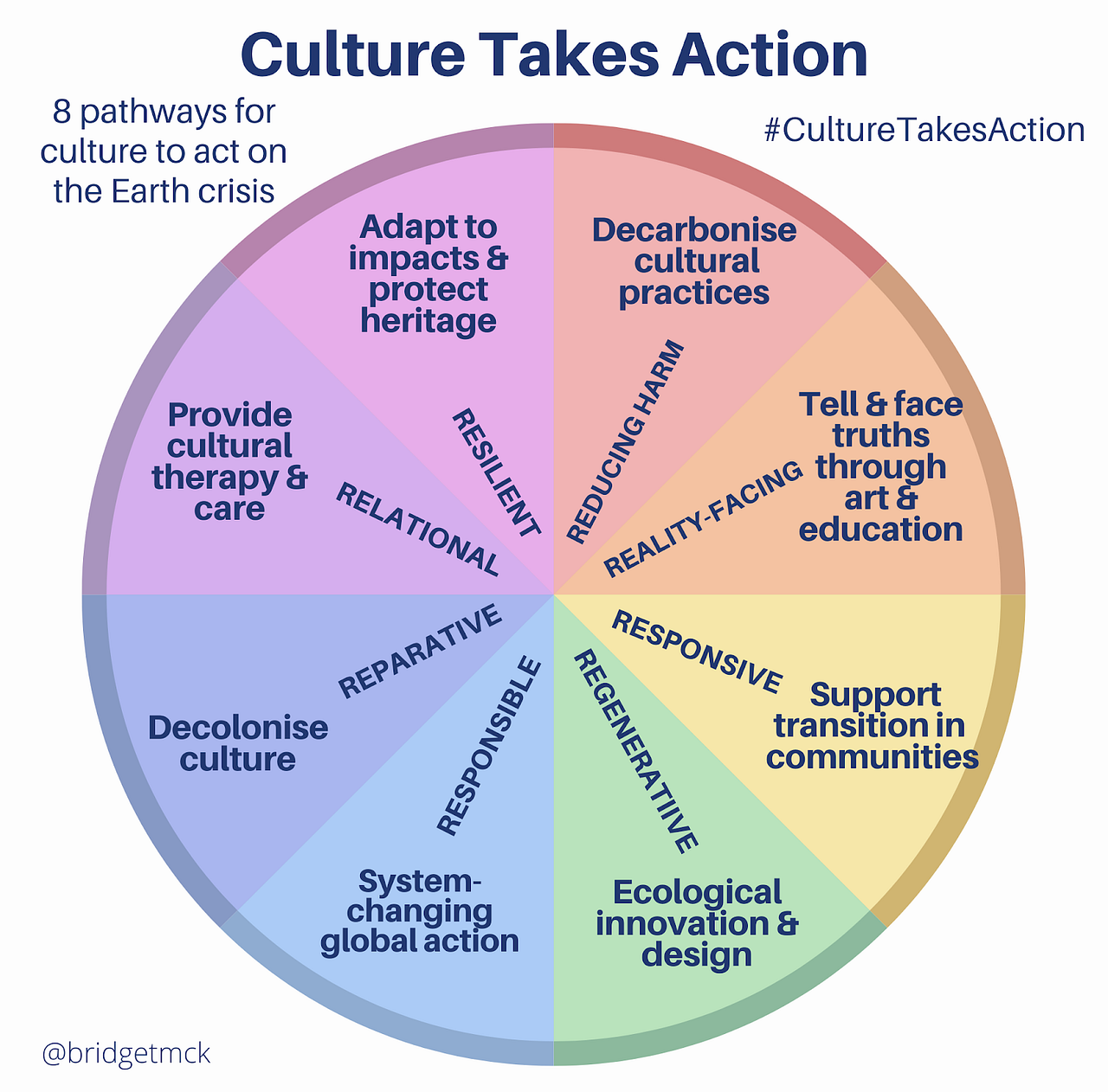
3. What is Adaptation?
The Intergovernmental Panel on Climate Change (IPCC) defines adaptation as: “adjustments in natural or human systems in response to actual or expected climatic stimuli or their effects, which moderates harm or exploits beneficial opportunities”.
Adapting to climate change will be necessary regardless of how much we manage to cut our carbon emissions. This is because historic emissions have already changed our climate and will continue to do so in the decades to come. We also need to adapt to the impacts of other environmental harms such as pollution and biodiversity loss, while we work to clean and restore our ecosystems.
Use this toolkit from Adaptation Scotland to access resources on how to anticipate impacts and how to plan adaptations for your type of building, locality and community.
Rupert Read, founder of the recently launched Climate Majority Project, explains why we need to take adaptation more seriously. Published in The Great Imagining newspaper, June 2023:
“We must take adaptation at least as seriously as mitigation and prevention. Most actions surrounding climate politics are centred around grand plans to avoid ecological breakdown through unpredictable geoengineering or unprecedented global diplomacy. A realistic review of scientific research on climate breakdown reveals that it may already be unavoidable; the integrity of our ecological system is jeopardised. We should dedicate a large proportion of our time, energy and resources into adaptation to the probable ecological collapse, because it is unlikely that even our best efforts at mitigation will be enough to thwart climate breakdown. So far adaptation has not received the attention it deserves since taking adaptation seriously would mean we can no longer deny just how bad the situation is. Adaptation requires an honest confrontation with the most inconvenient of truths, but that is preferable to the alternative, a half-hearted focus on mitigation that leaves us unprepared to live in a future of ecological carnage. Upon concluding that climate breakdown is probable, we must act to adapt so that we might avoid hardships of the future more ably. Adaptation should certainly not result in us giving up on trying to avoid ecological collapse, but unless we prepare for the worst and probable outcome, we risk an even bleaker future, that is why it is time for transformative and (deep) adaptation.”
The Climate Majority Project works to shift mainstream climate narratives towards truthfulness and to build resilience in response to the challenges that lie ahead. It is not against direct non-violent action but seeks to involve the majority of people in a range of actions according to means and needs.
4. What is Transition?
- Transition is change that takes place on a larger, systemic scale and is longer-lasting. Within the environmental movement, ‘Transition’ has become known as a particular network (Transition Network) and a range of tactics for shifting to a post-carbon and local economy, driven to achieve the wellbeing of people and nature rather than the profit of corporations. The Transition Network is described as “a movement of communities coming together to reimagine and rebuild our world”.
- Transition is very closely connected to the Degrowth movement. This critiques the global capitalist system which pursues growth at all costs, causing human exploitation and environmental destruction. It advocates for societies that prioritise social and ecological well-being instead of corporate profits, over-production and excess consumption.
- Transition is also linked to the idea of Doughnut Economics, an approach applied in places to achieve a social foundation to meet all people’s needs within the limits of the Earth’s operating system. It was devised by Kate Raworth.
- Rob Hopkins is a key founder of the Transition movement, who is now focused on the role of the Imagination to enable us to create the better world we know is possible. He is working with founders of Culture Declares amongst others to enrich this work with arts and creativity.
There are many possibilities for arts, design and heritage to work in a local place-based way, and to intervene in larger systems (e.g. politics and law) to bring about the transitions described above. See The Happy Museum Project for resources around this.
5. What is Resilience?
Resilience is a concept used in Adaptation. It is the ability to withstand or recover quickly from challenges and shocks. It has several layers, all of which offer some considerations for the cultural sector:
- Mental resilience: resilient individuals are able to manage stress and recover energy after difficulties, to look ahead, take next steps and help other people. (Some people have very resilient characteristics, but everyone can be MORE resilient if the conditions help them to be so.)
- Community resilience: places have resources so that people (and animals) can access food, energy, shelter and medicine in response to difficulties such as extreme weather or conflict. There are strong relationships and services are run that can help people equally without prejudice.
- Business resilience: organisations are able to continue operating but in ways that minimise their activity, protect their assets and that begin to reduce harms that worsen the impacts on themselves and their communities.
- Weatherisation: Buildings and other infrastructure are protected against extreme weather, such as with shutters against storms, effective storm drainage, electricity moved to higher levels when in flood zones, or more stable roofing.
- Ruggedisation: This is wider than weatherisation, to include a range of measures for an entire community or region to be protected against unpredictable events such as extreme weather, increased seismic activity (linked to climate change), mass displacement of people, zoonotic pandemics, collapse of species populations and extreme pollution events.
6. What is being Collapse-aware?
Collapse is a rapid falling, crumbling or disappearing of structures. When people talk about being Collapse-aware in environmental terms, they are talking about intersecting collapses, happening at different or unpredictable timescales:
- Collapse of a functioning climate system, with the melting of polar ice, warming oceans and shifting of the ocean’s jet streams
- Collapse of species populations (e.g. several species of pollinators)
- Collapse of particular ecosystems (e.g. the Great Barrier Reef)
- Collapse of functioning settlements, democracies and economies (e.g. after the extreme floods submerging a third of Pakistan there is food insecurity and large-scale emigration)
- Stress and collapse of part of the global systems of food, employment migration, shipping of goods, international security and democracy.
Being Collapse-aware for those of us in the Cultural sector should mean awareness (and raising awareness) of many historic and ongoing collapses of communities and ecosystems caused by extractive colonialism. Apocalypse has already happened for many peoples and places, with displacement, enslavement, large-scale ecocides and genocides. This is why Collapse-awareness must centre justice, not just as a value, but taking an active direction towards reparations.
Read my piece about how the Cultural sector needs to shift from a focus on Sustainability (keeping things going) to being Collapse-aware (responding to a world in which very little will keep on going).
Also, you may find my People Take Action toolkit useful for working with your group or local community to increase and scale up the range of actions they can take.

